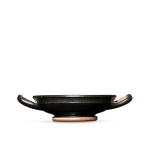Greek
An Attic black-glazed stemless kylix, Circa 480 - 450 BC
Pottery
Width including handles: 22.1 cm
Provenance
Nostell Priory Collection, Yorkshire, acquired by Charles Winn (1795-1874) in the 19th centuryChristie's, London, Greek and Etruscan Vases from Nostell Priory, 30 April 1975, lot 4
Nostell is one of the great treasure houses of the north of England. It dates from 1733, and was built for the Winn family on the site of a medieval priory.
Charles Winn (1795-1874) unexpectedly inherited the Nostell estate after the death of his brother John in 1817. As well as transforming the property, Charles as a keen scholar also established a taste for antiques and started to collect in the tradition of his eighteenth-century ancestors. One of his first acts was the acquisition of an important collection of ancient Etruscan vases 'for the moderate sum of 500 [pounds sterling', which his brother, John, had found in Naples whilst on the Grand Tour. Described at that time as 'the second most substantial collection of Greek vases in this country which is still in private hands', it was sold and dispersed in 1975. However, a few items have since been reacquired by the National Trust and are now displayed on the mantelpiece in the Billiard Room.
Literature
Perhaps because the skyphos performed a similar function, stemless kylikes only began at the end of the 6th century BC and became popular during the second quarter of the 5th. They continued into the 4th century BC, when black-glazed examples became particularly prevalent.Stemless kylix cups were used as drinking vessels in the ancient Greek world. These vessels were most likely used at the symposium, an all male drinking party. It was thought that the kylix cup would have been shared around the party and be a communal drinking vessel. It is common to find eye imagery on drinking cups, such as on the underside of the Kallos example, as it was thought to ward off evil spirits from entering the wine.
For a similar example see, B. A. Sparkes and L. Talcott, The Athenian Agora, Vol.XII, Black and Plain Pottery of the 6th, 5th and 4th centuries BC, Part 2 (Princeton, 1970), pl.22, no.473



